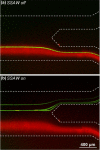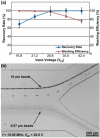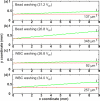Standing surface acoustic wave (SSAW)-based cell washing
- PMID: 25372273
- PMCID: PMC4442640
- DOI: 10.1039/c4lc00903g
Standing surface acoustic wave (SSAW)-based cell washing
Abstract
Cell/bead washing is an indispensable sample preparation procedure used in various cell studies and analytical processes. In this article, we report a standing surface acoustic wave (SSAW)-based microfluidic device for cell and bead washing in a continuous flow. In our approach, the acoustic radiation force generated in a SSAW field is utilized to actively extract cells or beads from their original medium. A unique configuration of tilted-angle standing surface acoustic wave (taSSAW) is employed in our device, enabling us to wash beads with >98% recovery rate and >97% washing efficiency. We also demonstrate the functionality of our device by preparing high-purity (>97%) white blood cells from lysed blood samples through cell washing. Our SSAW-based cell/bead washing device has the advantages of label-free manipulation, simplicity, high biocompatibility, high recovery rate, and high washing efficiency. It can be useful for many lab-on-a-chip applications.
Figures





References
-
- Butcher EC, Weissman IL. J. Immunol. Methods. 1980;37:97–108. - PubMed
-
- Sánchez-Salinas A, Cabañas-Perianes V, Blanquer M, Majado MJ, Insausti CL, Monserrat J, Sánchez-Ibáñez MV, Menchón P, García-Hernández A, Gómez-Espuch J, Morales A, M J. Moraleda, Transfusion. 2012;52:2382–2386. - PubMed
-
- Calmels B, Houzé P, Hengesse J-C, Ducrot T, Malenfant C, Chabannon C. Bone Marrow Transplant. 2003;31:823–828. - PubMed
Publication types
MeSH terms
Grants and funding
LinkOut - more resources
Full Text Sources
Other Literature Sources
Miscellaneous

